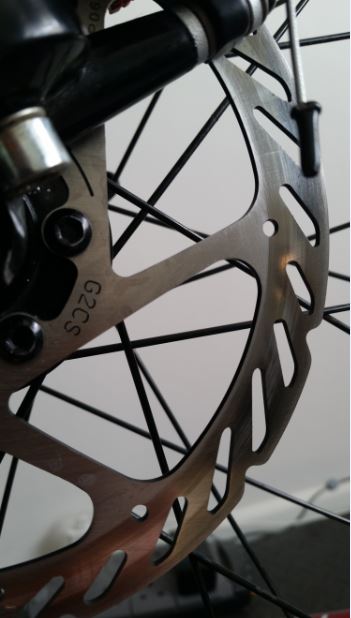I have a lot to say about the BB5's, so sorry for the long response.
The Avid BB5 brake pads can be difficult to get completely parallel to each other and to the rotor, due to (1) the shape of the pad and spring that holds them apart, and (2) the caliper angle is adjustable in 2 separate axes of rotation and 2 axes of translation (most brakes don't have those extra conical washers). They work well, but you may have to live with some noise, and it is not unusual to have to set and re-set and re-set them before you get it to the point you are confident they are in just the right position. If you were looking for a better/easier brake you can upgrade to a BB7, which has a wider pad and spring that wraps around the pad and is generally more secure. Either way, I'd get yourself a trusty 5mm allen wrench and get comfortable with all of the adjustments to your caliper if you really want to be able to maintain and adjust them; otherwise, your bike shop should be able to set you up and show you the periodic things you can do to tighten them as they wear.
Make sure the pads are set all the way in the caliper (they should noticeably "click" in and the tabs that stick out of the top should be even - since you reported the uneven wear on either side of the rotor, I am suspicious that the outside pad on this caliper is not quite in all the way - but I can't see it, so I don't know); also make sure the spring is set far down enough that the little bends in the end of the spring are set in the holes in the brake pad. If one of the pads is still at a wonky angle, you can pull the spring out and manually adjust the kink in the spring to try to even out the pressure on the brake pad. If they are (heavily) used brakes, sometimes brake dust will build up inside the caliper, and washing it out with soapy water or blasting it with compressed air can help the pads set evenly all the way around. Sometimes, even if you do all that, the outside pad will still sit funny, with the bottom of the pad leaning in towards the rotor. In cases like this you can keep toiling for eternity in a Sisyphean struggle for perfectly adjusted brakes, or just accept that they work but don't sound as quiet as you would like.
The rotor should not bend noticeably when you apply the brakes, so that shouldn't be why the wear is uneven on each side of the rotor. Try to get the inside pad as close to the rotor as possible without it rubbing. Even if it rubs a little bit, due to the rotor being out of true for example, that is ok. When you squeeze the brake, if you can notice the rotor bending in, you probably need to tighten the inside pad. If the rotor bends just to one side, you need to re-position the caliper by loosening the two bolts that hold it on, finding the desired position, and tightening the two bolts carefully. If you tighten one too much without tightening the other, it will twist the caliper and you will have to repeat the process. So be gentle. Tighten one a bit, tighten the other a bit, repeat.
I would check the brake pads after a while, and if it looks like the top of the pads is not being worn away, adjust the caliper/caliper mount on the frame so that the brake pads are completely over the rotor. (or, you can just live with unevenly worn brakes, they just won't work as well and you'll have to replace them sooner)
If you took it to the bike shop and they said it was good, though, you're probably ok. Riding it for a while will set the pads in and even if its slightly unevenly adjusted, it will even out as it wears.
Also, secret (not really) adjustment: there is a ~2mm hex screw in the caliper that sets the spring tension. Your brakes will be easier to pull if you loosen this bolt ... its a matter of personal preference, but can make it more comfortable especially for extended use.


